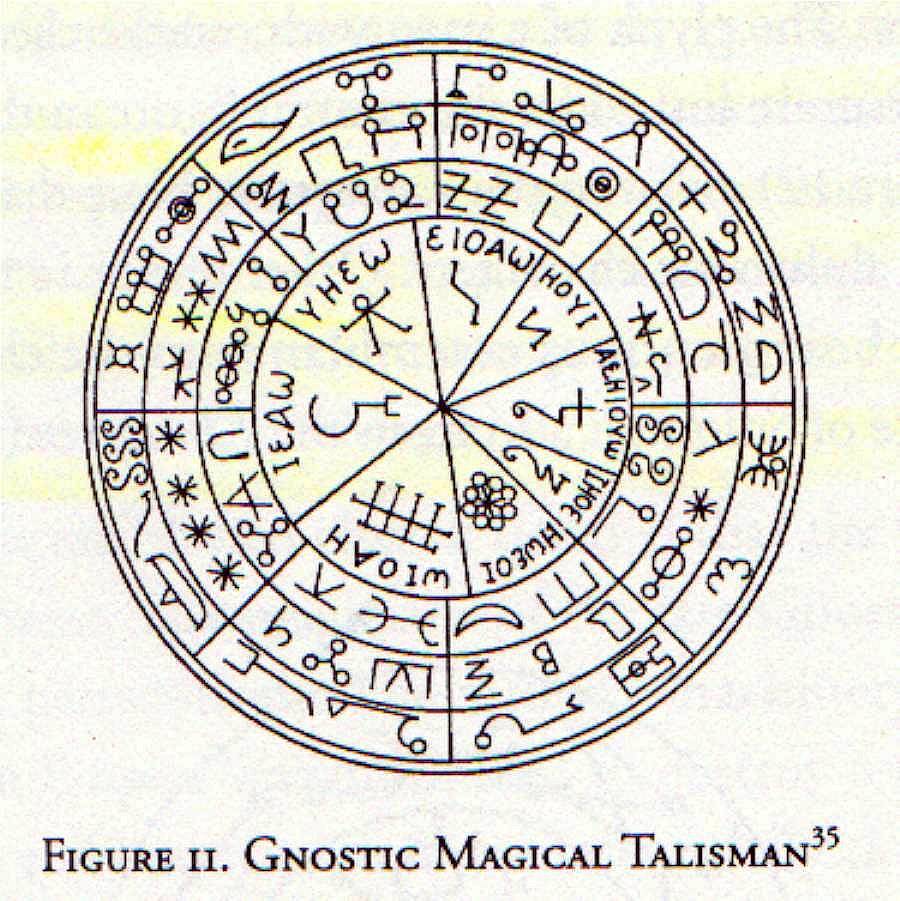
I found your website through the Webring and after learning of your credials, knowledge, and experience of the esoteric nature I could not resist the opportunity to inquire if perhaps you have some information or direction on a talisman which has become quite an important part of my life-path. I have spent much energy in the course of the past 4 years into seeking such information on this talisman. What little I have learned has come from intuition, a deep study of the city of Pergana/Pergamum, a two short paragraphs my guides led me to contained in Geoffrey James' book, ANGEL MAGIC. Without any prior knowledge of the existence of this particular talisman, it was oddly gifted to me on the eve of May 20th, 1996. A second one arrived similarly the next day. Approximately a year later, I received my third. Each seemed newly cast, but are apparently fairly rare to come by. It has been named to me as the Pergamum Bowl and as a Gnostic Magical Talisman. It is considered one of the earliest examples of a magical alphabet, which appears on a Gnostic artifact of the 3rd century AD and forms a substantial link between Gnostic talismans and medieval grimoires. It is suggested within its inner circle a relation to the Magical Square. Its characters are directly related to those in talismans in the grimoires. Through study of the Lemegeton, the Secret Seal of Solomon, the Pentacle of Solomon, the Black Book of Faust as well as Hebrew, Egyptian, and Chaldean talismans, I have but bits and pieces to this clue within my path. I have found within it lies great power and protection, but I long to know it more completely so that I may understand and apply it as it was meant within my spiritual journey. I also heard it appears on a pottery jar in the British Museum, however I was unable to follow that lead. If you could help me in any way you would be doing me an honorable and so appreciated service. I feel you are one of the few who might be able to help.
David Allen Hulse answered:
Thank you for the picture of the pergamum incantation bowl. The script used on the bowl is not extant, and there is no key, but I can offer some insights on its construction. I fear that there is some corruption in the copying of this talisman. Many times, the original, which ispristine in its magic, has been copied in ancient times by hand many many times, without ever being recorded. Thus each copy may blur its true meaning a little more. Here are my insights for what they are worth: The layout of the Gnostic talisman is twofold. There are three outer rings, each of 8 divisions, with lettering and symbols in each one. Then there is the inner ring of another eight, but not of equal divisions, and not perfectly aligned with the outer 24 divisions. Let's talk about the outer divisions first. They are the 24 letters of the Greek alphabet, and the triple ogdoad that was one model of the aeons before 30 world model was developed. Turn to page 15 of my second volume of the Key of it All in the Western Mysteries to find what these 3rings are. The inner ring is the primal ogdoad, the middle ring is the Planetary ogdoad and the outer rings the Sophiac Ogdoad. The first 8 letters of the Greek alphabet that begin with alpha fall to the inner ring, the next 8 to the middle ring, and the outer 8to the last eight that end in Omega. The center 8 rings are the 8 additional letters of the32 letter Coptic alphabet (see page 52 of the 8th key) making the Greek and the Coptic interlink. 32 is also the divisions of the Tree of Life. If this were a purely Greek talisman, this inner ring would only be of 6 to make the 24 total to the 30 aeons. But because there are 8, it links the Greek with the Coptic current of Gnosticism. In terms of the outer rings, some of the letters (the one's with circles connected by lines) are from a variation on the celestial alphabet. The circles are stars and the lines, the constellations formed from them. Notice that in the inner circle at about 2 o'clock there is a symbol missing, making this talismanin complete by one character. Note also that in the middle ring at about 8 o'clock is four 8 pointed stars. That is the pattern of this talisman (four 8 pointed mandalas as interlocking circles). In classic Hebrew, the T shaped celestial letter at the top is -Qoph and Pisces, the fence like symbol with two circles on top just below is the letter Cheth and Cancer, while the U shaped letter connecting two circles is the letter Teth and Leo. The moon is present in the inner circle at about 6 o' clock. Unfortunately there is not key, but each quadrant is an angel ruling over that aeon. Now to the center: It is out of alignment, 3 on one side, 5 on the other, and not aligned to the outer.